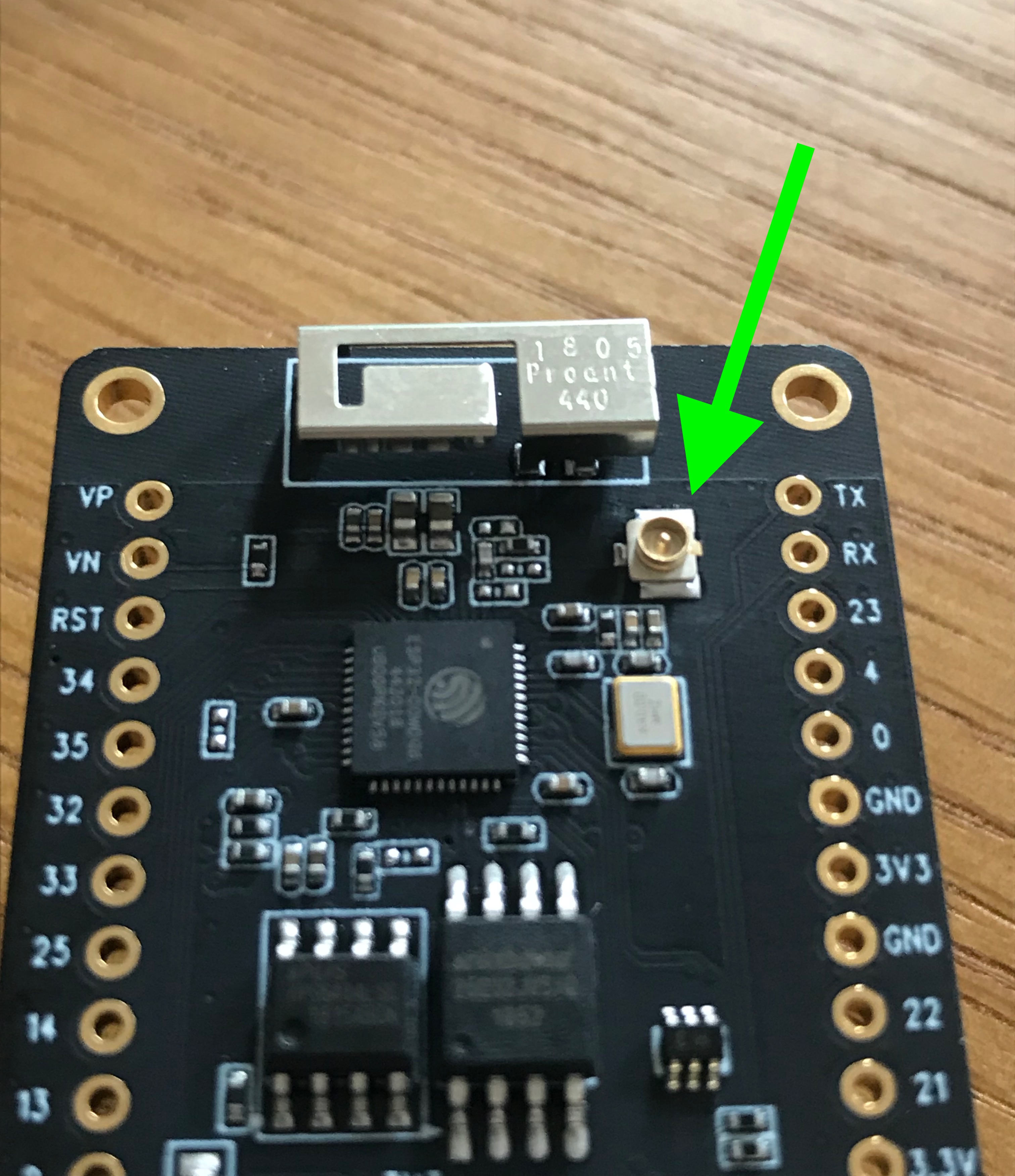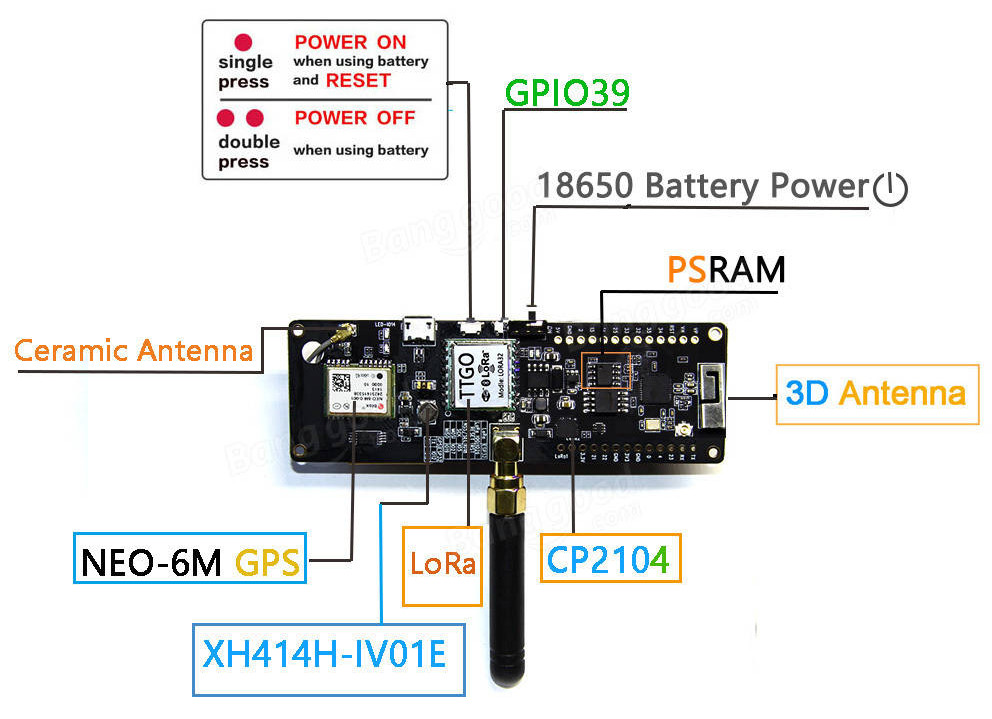nice. tnx.
“buying a new one is probably cheaper…” : No!! You don"t undestand.
I’m pratically sure that the mistake is not on MY board but on ALL TTGO V1 at 868Mhz:
There is a mystake in the layout: use of PAboost with wrong parts. Or it is only a BOM mistake
Understanding PA SX1276 is not obvious: many frequencies and BOM changes, many power configuration, 2 différents layout available, use or not EMI filter…not so easy as connecting an Oled Display.
Any way , if you are not able to do the measurement with specific hardware, you can not see the difference. 10dB Could be over-pass by good or bad cable and antenna. You will see it only for test at the limit range, with same antenna…
ok, therefore you can’t say that changing a few components will help if there is a fundamental design error.
To be clear : If you change theses components ( not easy ) and modify LMIC lib, you can improve de transmitted power, to be close to the semtech specification and RFM95
There is a video by Andreas Spiess about the ESP32 issues due to bad RF design . However, I agree that is likely better to buy an ESP32 alone + RFM95w instead.
I wonder what is this UFL connector for, does anyone know?
Wifi ?
It is meant for connecting an external Wifi/BT antenna but that would require moving (de/re-soldering) a 0 ohm resistor (on the left of the U.FL connector) from one location to another to switch the RF connection.
Not good for the Lora antenna then…
That is unrelated to the LoRa antenna (or at least as much related as the on-board Wifi/BT antenna).
Any luck/update with regards to the GPS and sleep mode?
Hello!
I’m new to the LoRaWAN and TTN community.
I’ve been trying to get my TTGO T-Beam to work (connect to TTN) for several days now, but have had no success whatsoever.
What I’ve tried so far:
- Downloaded LMIC library and tried out the following pinout settings according to the best TTGO T-Beam pinout information I’ve found so far (incl. soldering LoRa1 to pin 33 and LoRa2 to pin 32 on the board itself):
const lmic_pinmap lmic_pins = {
.nss = 18, // LoRa chip select on ttgo t-beam
.rxtx = LMIC_UNUSED_PIN,
.rst = LMIC_UNUSED_PIN, // Not required
.dio = {26, 33, 32}, // To LoRa DIO0 (interrupt), To LoRa DIO1 (interrupt) & To LoRa DIO2 (interrupt)
};
- Updated SPI settings in hal.cpp according to the correct SPI pinout:
static void hal_spi_init () {
// SPI.begin();
SPI.begin(5,19,27); // These specific pins are for TTGO T-Beam only!
}
- Tested LMIC AGP example, paying very close attention to little- and big-endian formats. This is what I see (no joining feedback, the last lines just repeat after every 60 seconds as defined):
Baud rate 115200
ets Jun 8 2016 00:22:57
rst:0x1 (POWERON_RESET),boot:0x33 (SPI_FAST_FLASH_BOOT)
configsip: 0, SPIWP:0xee
clk_drv:0x00,q_drv:0x00,d_drv:0x00,cs0_drv:0x00,hd_drv:0x00,wp_drv:0x00
mode:DIO, clock div:1
load:0x3fff0018,len:4
load:0x3fff001c,len:928
ho 0 tail 12 room 4
load:0x40078000,len:9280
load:0x40080400,len:5848
entry 0x40080698
Starting
11124: EV_TXSTART
Packet queued
206222: EV_TXCOMPLETE (includes waiting for RX windows)
- Tested LMIC OTAA example, paying very close attention to little- and big-endian formats. This is what I see:
Baud rate 9600 (the last lines just repeat)
⸮as⸮⸮J&&⸮SY
Packet queued
4918: EV_JOINING
4937: EV_TXSTART
414734: EV_TXSTART
843576: EV_TXSTART
1302692: EV_TXSTART
2665242: EV_TXSTART
- OTAA example. Baud rate 115200
ets Jun 8 2016 00:22:57
rst:0x1 (POWERON_RESET),boot:0x33 (SPI_FAST_FLASH_BOOT)
configsip: 0, SPIWP:0xee
clk_drv:0x00,q_drv:0x00,d_drv:0x00,cs0_drv:0x00,hd_drv:0x00,wp_drv:0x00
mode:DIO, clock div:1
load:0x3fff0018,len:4
load:0x3fff001c,len:928
ho 0 tail 12 room 4
load:0x40078000,len:9280
load:0x40080400,len:5848
entry 0x40080698
- Peeled off the LoRa module sticker to make sure I do not have the 433 MHz LoRa module as I did have with other LoRa modules I failed with as I live in Europe. Although it is not the 433 MHz module, I found HPD13A-915 written on top of the module. Knowing that the TTGO T-Beam advertises itself to be compatible with 868 MHz and 915 MHz at the same time (?!), might this prove to be a problem? I do have to admit I’m too novice in this to make sure, so any feedback on this would be fantastic.
Going through numerous topics on TTGO T-Beam and different examples, the board itself works and I’ve managed to upload code onto it, but I cannot seem to connect with the TTN. Any help or extra questions to give input to would be greatly appreciated!
PS. I am using The Things Gateway for testing.
Thanks!
-Tarvo.
see
If you have the older TTGO T-Beam Version you need to wire Lora Pin DIO1 to CPU.
You can also check paxcounter software which comes with tailored settings for TTGO T-Beam, perhaps it works on your’s. If yes, you know that you did something wrong.
Thanks for the tip. Could You please elaborate to where I would have to wire the LoRa DIO1 in case I need to?
I’ve had a look at the Paxcounter before, but haven’t really tried uploading it to the T-Beam that as it seemed a bit too complex code to begin my exploration with, but I will try it out. Hopefully it reveal something. 
EDIT: Paxcounter works fine, I was able to connect to TTN and forward data. So what mightbe up with the previous codes? 
Well first make sure you have a version which needs the wiring.
Can you find any version marking on the board ? Please copy it here.
Later : I just saw your edit. You definitely do not need more wiring if paxcounter works.
Double-check your pinout and your keys.
Pinout of TTGO-Tbeam can be found here:
i’m not sure if this is the right place to post my question about TTGO T beam. It’s my first ESP board and my very first project with ESP and lora. my question is simple, can i use my board without battery, just power it on using only USB (connected to PC). I already tried that because i though it’s fine, like almost every single board in the market has an USB port for power and programming, but the moment i turn the switch on i heard some noise.i’m not sure if the noise is from Lora component or not but i think it is, so i just turned off.
why not

